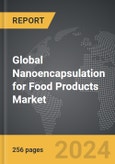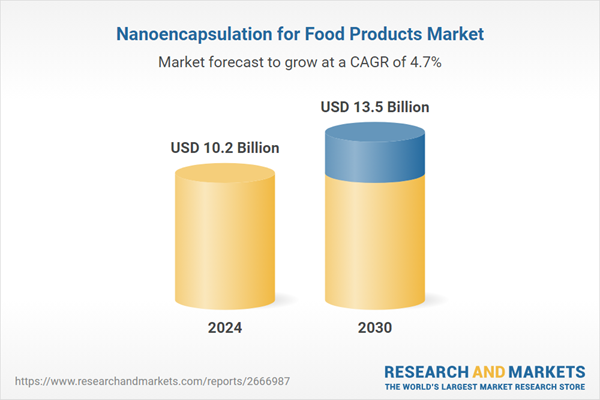The global market for Nanoencapsulation for Food Products was valued at US$10.2 Billion in 2024 and is projected to reach US$13.5 Billion by 2030, growing at a CAGR of 4.7% over the analysis period 2024-2030. The report includes the most recent global tariff developments and how they impact the Nanoencapsulation for Food Products market.Nanoencapsulation to Transform Food Industry
Global Nanoencapsulation for Food Products Market - Key Trends and Drivers Summarized
Nanoencapsulation technology is significantly reshaping the food industry by enhancing the stability, solubility, and bioavailability of natural compounds in food products. This innovative approach is particularly critical as consumer preferences shift towards natural, nutritious, and minimally processed foods. By enclosing bioactive compounds in nano-sized carriers, nanoencapsulation protects these ingredients from degradation caused by environmental factors and processing conditions, and ensures their controlled release during digestion. This technology facilitates the effective integration of natural ingredients such as vitamins, antioxidants, and plant extracts into various food products, thereby maintaining their efficacy throughout the production chain, from processing to storage and consumption. As such, nanoencapsulation meets the growing demand for healthier food options and aligns with the clean label trend, which favors products free from synthetic additives.The technology underpinning nanoencapsulation includes a variety of systems such as polymer-based, lipidic, and metallic nanocarriers, each offering unique benefits for food production. Polymer-based systems are versatile, capable of encapsulating both hydrophilic and hydrophobic substances, while lipidic systems like liposomes provide a biocompatible and often biodegradable matrix, ideal for food applications. Metallic nanoparticles are employed for their structural robustness and functional properties, such as antimicrobial activity, which are essential in food preservation. The integration of nanoencapsulation into the food manufacturing process is seamless, allowing for the incorporation of encapsulated ingredients at various stages without compromising the integrity of the food matrix. The evolution of nanoencapsulation techniques has led to more sustainable practices that reduce the reliance on harmful solvents, emphasizing eco-friendly approaches in food processing.
Looking forward, the expansion of nanoencapsulation in the food industry is driven by several key factors. There is a marked increase in consumer demand for food products that incorporate natural and healthy ingredients without sacrificing quality or efficacy, which nanoencapsulation technology can uniquely provide. The ability to enhance the bioavailability of nutrients and improve the stability and shelf life of food products addresses both consumer and manufacturer needs, leading to wider adoption. Regulatory trends favoring reduced synthetic additives further boost the appeal of nanoencapsulation. Additionally, ongoing advancements in technology that improve the efficiency and environmental impact of nanoencapsulation processes are likely to spur further innovation. This includes the development of new encapsulation materials and methods that enhance the control, scalability, and cost-effectiveness of nanoencapsulation, making it an increasingly vital component of modern food production and a key player in the global effort to meet enhanced food safety, quality, and sustainability standards.
Report Scope
The report analyzes the Nanoencapsulation for Food Products market, presented in terms of market value. The analysis covers the key segments and geographic regions outlined below.- Segments: Segment (Nanoencapsulation for Food Products).
- Geographic Regions/Countries: World; United States; Canada; Japan; China; Europe (France; Germany; Italy; United Kingdom; and Rest of Europe); Asia-Pacific; Rest of World.
Regional Analysis
Gain insights into the U.S. market, valued at $2.8 Billion in 2024, and China, forecasted to grow at an impressive 4.4% CAGR to reach $2.1 Billion by 2030. Discover growth trends in other key regions, including Japan, Canada, Germany, and the Asia-Pacific.Why You Should Buy This Report:
- Detailed Market Analysis: Access a thorough analysis of the Global Nanoencapsulation for Food Products Market, covering all major geographic regions and market segments.
- Competitive Insights: Get an overview of the competitive landscape, including the market presence of major players across different geographies.
- Future Trends and Drivers: Understand the key trends and drivers shaping the future of the Global Nanoencapsulation for Food Products Market.
- Actionable Insights: Benefit from actionable insights that can help you identify new revenue opportunities and make strategic business decisions.
Key Questions Answered:
- How is the Global Nanoencapsulation for Food Products Market expected to evolve by 2030?
- What are the main drivers and restraints affecting the market?
- Which market segments will grow the most over the forecast period?
- How will market shares for different regions and segments change by 2030?
- Who are the leading players in the market, and what are their prospects?
Report Features:
- Comprehensive Market Data: Independent analysis of annual sales and market forecasts in US$ Million from 2024 to 2030.
- In-Depth Regional Analysis: Detailed insights into key markets, including the U.S., China, Japan, Canada, Europe, Asia-Pacific, Latin America, Middle East, and Africa.
- Company Profiles: Coverage of players such as ASUSTeK Computer, Inc., Faraday Technology Corporation, Greenliant Systems, Ltd., Hewlett-Packard Development Company LP, Kingston Technology Co., Inc. and more.
- Complimentary Updates: Receive free report updates for one year to keep you informed of the latest market developments.
Some of the 7 companies featured in this Nanoencapsulation for Food Products market report include:
- ANP Technologies Inc.
- Aquanova AG
- Blue California
- Carlina Technologies
- Encapsula NanoSciences LLC
- Frutarom Industries Ltd.
- Matinas Biopharma Hldgs.
- Powderment Inc.
- Southwest Research Institute
- Thies Technology Inc.
This edition integrates the latest global trade and economic shifts into comprehensive market analysis. Key updates include:
- Tariff and Trade Impact: Insights into global tariff negotiations across 180+ countries, with analysis of supply chain turbulence, sourcing disruptions, and geographic realignment. Special focus on 2025 as a pivotal year for trade tensions, including updated perspectives on the Trump-era tariffs.
- Adjusted Forecasts and Analytics: Revised global and regional market forecasts through 2030, incorporating tariff effects, economic uncertainty, and structural changes in globalization. Includes historical analysis from 2015 to 2023.
- Strategic Market Dynamics: Evaluation of revised market prospects, regional outlooks, and key economic indicators such as population and urbanization trends.
- Innovation & Technology Trends: Latest developments in product and process innovation, emerging technologies, and key industry drivers shaping the competitive landscape.
- Competitive Intelligence: Updated global market share estimates for 2025, competitive positioning of major players (Strong/Active/Niche/Trivial), and refined focus on leading global brands and core players.
- Expert Insight & Commentary: Strategic analysis from economists, trade experts, and domain specialists to contextualize market shifts and identify emerging opportunities.
Table of Contents
Companies Mentioned (Partial List)
A selection of companies mentioned in this report includes, but is not limited to:
- ANP Technologies Inc.
- Aquanova AG
- Blue California
- Carlina Technologies
- Encapsula NanoSciences LLC
- Frutarom Industries Ltd.
- Matinas Biopharma Hldgs.
- Powderment Inc.
- Southwest Research Institute
- Thies Technology Inc.
Table Information
| Report Attribute | Details |
|---|---|
| No. of Pages | 256 |
| Published | December 2025 |
| Forecast Period | 2024 - 2030 |
| Estimated Market Value ( USD | $ 10.2 Billion |
| Forecasted Market Value ( USD | $ 13.5 Billion |
| Compound Annual Growth Rate | 4.7% |
| Regions Covered | Global |









